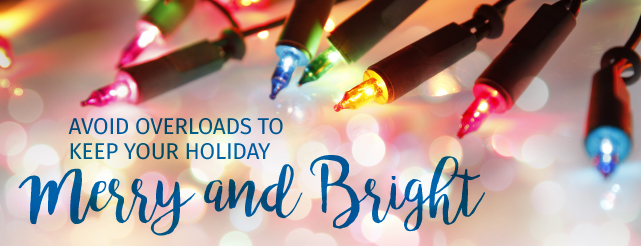Avoid Overloads to Keep Your Holiday Merry and Bright

Nothing invokes cheery holiday spirit better than a sparkling Christmas tree and a brilliant lawn display. But that festive feeling can hit with a thud if an electrical overload causes the power to go out.
An overload occurs when the device draws more electricity than a circuit can safely handle. A breaker shuts off the circuit, preventing wires from overheating and starting a fire.
Avoid the threat of tripped breakers by following these tips from Brad Adcock, Walton EMC’s director of safety and training.
LOOK INTO LEDS. Switching from conventional incandescent lights to LEDs makes your electrical load more than seven times smaller and has the same effect on your holiday electric bill. That alone might easily solve your overload problems.
INSPECT FIRST. Check power cords for damage. Throw away light strands that are frayed or kinked or have broken bulbs.
READ THE LABEL. Note the power supply requirements for each item. Find this information on packaging, on a label attached to light strings or stamped on the plug or bottom of a decoration.
ADD UP THE AMPS. Using the power supply requirements you noted, determine the amps each device or string of lights will require. If a decoration provides an amperage rating, you’re all set. If it gives you only the wattage, divide the wattage number by 120 to find the amperage. For example, if a light string uses 250 watts, the amperage draw will be 2.08 amps (250/120 = 2.08).
The rule of thumb is not to load a circuit over 80 percent, meaning a 20-amp circuit can safely handle 16 amps, and a 15-amp circuit can safely handle 12 amps.
COUNT THE CONNECTIONS. Follow manufacturer suggestions regarding the maximum number of light strings you can safely connect together.
PLUG RESPONSIBLY. Plug lights or decorations directly into an outlet whenever possible. Don’t plug decorations into power strips that are plugged into extension cords that are plugged into outlets. And don’t plug a bunch of power strips into a single outlet or daisy-chain extension cords together.
USE GFCI OUTLETS. Plug outdoor decorations into ground-fault circuit interrupter (GFCI) outlets. GFCIs will automatically shut off if the current becomes unbalanced, preventing electric shock.
WATCH FOR WARNING SIGNS. Signs of an overloaded circuit include power cords that are warm or hot to the touch; flickering, blinking or dimming lights; outlet covers that are warm or emit burning odors; crackling, sizzling or buzzing receptacles; a mild shock or tingle when touching appliances, receptacles or switches and frequently tripped circuit breakers.
If a circuit breaker does trip, it’s a sign that it’s overloaded. Try reducing the number of devices running on it. If circuits continue to overload, unplug your Christmas decorations until a licensed electrician can check your electrical system.
